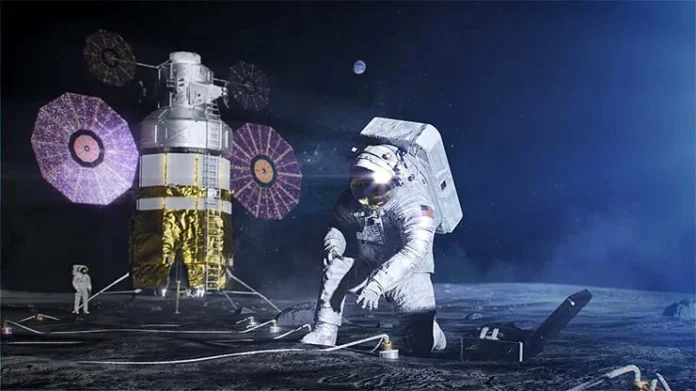Lunar rovers are ideally suited for exploring the Moon due to their ability to endure the challenging conditions of its surface, including darkness, extreme cold, radiation, and difficult terrain. Furthermore, rovers surpass human capabilities, allowing them to cover extensive distances and gather a wealth of data. Engineers must meticulously consider these factors when designing lunar rovers, as they present significant obstacles that must be overcome for a rover’s safe and successful operation on the Moon. Let us delve into each of these challenges and explore how rovers are engineered to surmount them.
The Moon exhibits synchronous rotation with Earth, implying that it rotates on its axis at the same rate as it orbits our planet. Consequently, we always perceive the same side of the Moon from Earth. As the Moon orbits the Earth, each side experiences 14 Earth days of illumination (lunar day) followed by 14 Earth days of darkness (lunar night).
Certain regions on the Moon’s poles remain perpetually shrouded in darkness. These regions are known as ‘permanently shadowed regions’ (PSRs), where the Sun remains perpetually low relative to the horizon, resulting in constant darkness within the craters. These craters are formed through impacts when asteroids or comets collide with the Moon’s surface. Craters can vary greatly in size, ranging from a few meters to hundreds of kilometers wide. The Moon boasts millions of craters dispersed throughout its surface.
SHROUD OF DARKNESS
Rovers rely on solar panels for power, rendering them inoperable during periods of darkness. Without power, rovers are unable to move, utilise their instruments, or establish communication with Earth. Solar panels are solely functional in the presence of sunlight. As solar panels are delicate and prone to damage during launch and landing, engineers must design robust panels capable of withstanding the rigors of space travel. Additionally, they must carefully package them to shield against potential harm.
To survive the lunar night, rovers must recharge their batteries when sunlight is available. This enables them to utilise their heaters during the lengthy and frigid lunar night. Rovers can also recharge their batteries by connecting to a nearby lunar lander, which serves as a home base, providing docking capabilities and battery recharging support. Through the use of docking software, rovers can locate and connect to the lander, subsequently employing wireless charging to replenish their batteries.
FIGHTING THE EXTREME COLD
The Moon’s surface experiences drastic temperature fluctuations between day and night. Daytime temperatures can soar to a scorching 127°C, while plummeting to a bone-chilling -173°C during the night. The temperatures can further decrease within craters perpetually cast in shadows. The lowest recorded temperature in the solar system was measured within the Hermite Crater on the Moon, reaching approximately -250°C.
The Moon’s poles also harbor the coldest temperatures in the solar system due to their perpetual lack of sunlight. These regions remain exceedingly cold, making it impossible for spacecraft to land there. Scientists have only been able to study these areas using remote-sensing instruments. Rovers tasked with exploring craters and PSRs on the Moon must be engineered to withstand these extreme cold temperatures. Consequently, rovers will employ various methods to maintain a safe internal temperature, thereby posing new challenges to engineers in terms of insulation and temperature regulation.
THE GOLD INSULATION
Rovers can be coated with a layer of gold to prevent the transfer of heat through radiation, similar to how a thermos flask retains heat. Another effective insulation option for rovers is aerogel, a lightweight material consisting of 99.8% air. Air serves as an excellent insulator, making aerogel an ideal choice for space missions.
TEMPERATURE CONTROL
Rovers are equipped with temperature control systems that include heaters and heat rejection mechanisms. The heaters are regulated by a thermostat, enabling them to automatically switch on and off as needed. The heat rejection system employs a pump and tubing to release excess heat into space, functioning akin to an air-conditioning system in a car.
COSMIC RAY RADIATION
Cosmic rays, which are high-energy particles traveling through space, pose significant dangers to both astronauts and equipment in space. They can cause radiation sickness and damage electronic components. Unlike Earth, the Moon lacks the protective shield provided by the atmosphere and magnetic field, making it highly exposed to high levels of radiation.
Astronauts on the Moon would experience radiation levels up to 200-1,000 times higher than those on Earth and 2½ times higher than those on the International Space Station (ISS). These elevated radiation levels can lead to cancer and other health issues. Moreover, the lunar rover’s electrical systems are susceptible to radiation damage, including malfunctions in computer chips and memory loss.
Radiation can also cause the insulation on wires to become brittle, increasing the risk of short circuits. To counteract this, lunar rovers employ shielded wires that are resistant to radiation damage. Typically, shielded cables consist of a black plastic jacket on the outside, a braided wire shield beneath it, and a white insulating material underneath the shield. Different colored wires extend from the end of the cable.
A CHALLENGING TERRAIN
Although the Moon’s surface may appear flat and smooth from Earth, it is actually quite diverse. It consists of flat areas as well as steep, rocky formations and deep craters. Rovers need to possess the ability to climb, maneuver over obstacles, and avoid becoming trapped in soft soil or sand in order to explore this varied lunar terrain.
ROVER WHEEL TECHNOLOGY
Rovers designed for lunar exploration require specially engineered wheels capable of withstanding the sharp rocks and microscopic shards of jagged rock found in the lunar regolith. These wheels must feature robust treads to provide adequate traction on the powdery lunar regolith, which can be slippery to drive on. To evaluate a rover’s performance on the Moon, engineers conduct test drives on simulated lunar surfaces made from materials that mimic the properties of real lunar soil.
Rover wheels need to be designed to facilitate climbing and descending steep crater walls. They often feature deep grooves, spikes, or mesh patterns. Operators are trained to avoid areas where the rover may become stuck. NASA has developed a novel rover design called DuAxel, comprising two two-wheeled vehicles connected by a cable. This configuration enables the rover to move one vehicle at a time, enhancing stability on steep slopes.
DEALING WITH THE DUST
Moon dust, consisting of fine, powdery particles, poses a hazard due to its sharpness, comparable to glass. It can enter astronauts’ lungs and interfere with machinery. Moon dust is exceptionally sharp because the Moon lacks water and air to weather it down over time, as occurs on Earth. The sharp particles have a static charge, causing them to adhere to surfaces. This presents challenges for astronauts and their equipment alike.
If dust accumulates on a rover’s cameras, it can significantly impair the driver’s visibility, potentially leading to accidents or crashes. Additionally, dust can infiltrate the rover’s mechanical components, causing them to malfunction or cease functioning altogether. To address these issues, engineers are actively exploring various methods, such as employing electrical charges to repel dust and applying dust-resistant coatings, to prevent dust accumulation on astronaut spacesuits and rovers.
THE PRAGYAN ROVER
The Indian Space Research Organisation (ISRO) has developed the rover for the Chandrayaan-3 mission, named Pragyan, meaning ‘wisdom’ in Sanskrit. Pragyan is equipped to conduct in situ chemical analysis of the lunar surface as it traverses the Moon’s terrain.
The six-wheeled rover measures approximately 1.6 meters in length and 1 meter in width. It carries two payloads: the Alpha Particle X-ray Spectrometer (APXS) and the Laser-Induced Breakdown Spectroscope (LIBS). These instruments enable the analysis of the elemental composition and mineralogy of the lunar surface, respectively.
Designed to cover a distance of up to 500 meters on the lunar surface, the Pragyan rover is expected to operate for about one lunar day, equivalent to approximately 14 Earth days, as its electronics are not designed to withstand the extreme cold of the lunar night. Upon successful landing on the lunar surface, the rover will be deployed from the Vikram lander. Communication between the rover and Earth will be facilitated through the orbiter deployed by the Chandrayaan-2 mission.
The development of the Pragyan rover marks a significant milestone for ISRO, as it is India’s first indigenous lunar exploration rover. The successful deployment of the rover will be a remarkable achievement for ISRO and further enhance India’s capabilities in space exploration.
-The writer is a Defence, Aerospace & Political analyst. The views expressed are personal and do not necessarily reflect the views of Raksha Anirveda
-The author is a Defence, Aerospace & Political Analyst based in Bengaluru. He is also Director of ADD Engineering Components, India, Pvt. Ltd, a subsidiary of ADD Engineering GmbH, Germany. You can reach him at: girishlinganna@gmail.com. The views expressed are personal and do not necessarily carry the views of Raksha Anirveda












